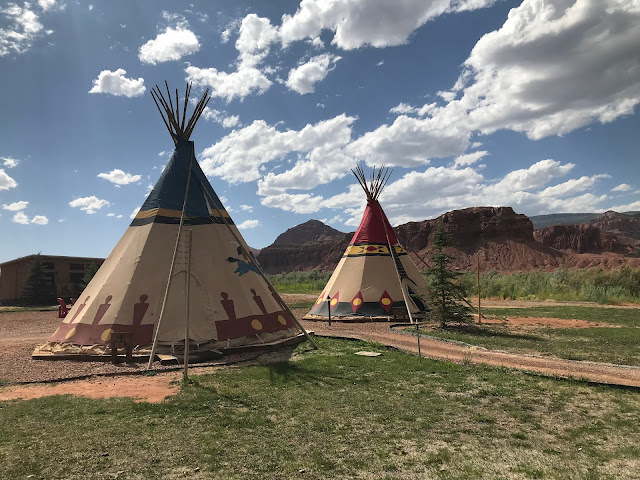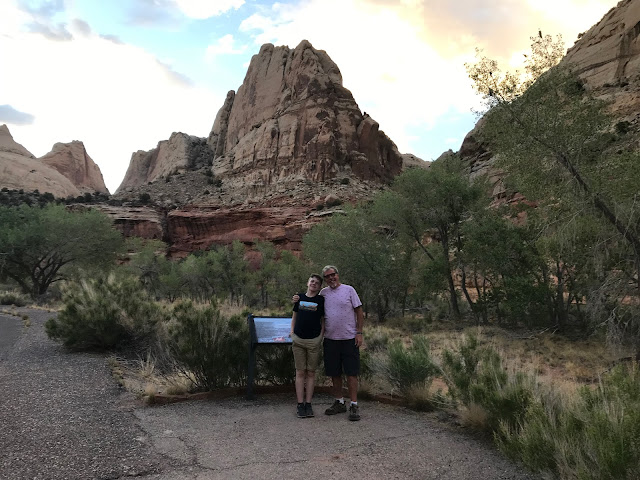After two quick days in Moab, Utah, we were off to see the next of the Mighty Five--Capitol Reef National Park. Compared to the other five National Parks, Capitol Reef is the most expansive and least crowded. Travel bloggers explained that many visitors bypass Capitol Reef because of its remote location; however, those who made the trip LOVED it.
The feature near the park that sealed the deal for me was Capitol Reef Resort, which offered teepees and Conestoga Wagons for sleeping accommodations. To book a teepee, I would need to schedule a minimum three-night stay; for the wagon, the minimum was two nights. Before making the decision, I had a family meeting. "Which one guys? There are enough beds in the wagon, but for the teepee, Lewie will need to sleep on a cot," I remarked. The decision was unanimous; everyone wanted to sleep in the teepee!
Our trip from Moab to Torrey took two hours, mostly through dry, flat land. I knew when we reached the actual park because huge dome and castle-like structures towered over us on the right side of the highway. We stopped to take pictures. The resort, which was even more beautiful in person, was a ten-minute drive from the park entrance. When we checked in, they handed us a key for the bathroom and a tiny key for a lock, which was used to keep the teepee zipper in place. (It was a little nerve-wracking to know that anyone could simply cut through the canvas of the teepee to get inside, but once we met everyone at our campsite, primarily families with children, my anxiety disappeared.)
When we first stepped into the teepee in the ninety-degree heat, we felt like we entered a sauna. A mobile air conditioning unit was roaring on its highest setting, but there was no cool relief in the slightest. Knowing how much my two boys hate to be hot, I panicked. What if the teepee never cooled down, and they had to sleep in these conditions? I would never hear the end of it!
Lucky for me, while the days were hot, the nights were cold--almost too cold--a brisk 40 degrees. So, when the sun set, we were trading the air conditioning for heavy blankets. (There was a trunk inside the teepee that had even more blankets, but we didn't notice it until the day we left!) Getting up in the middle of the night to use the bathroom was tough. While the bathroom facility was clean and warm, getting out of the warm bed, unzipping the teepee, walking through the whipping wind, and then zipping and locking the teepee back up was not pleasant. After learning from my first midnight bathroom run, each night thereafter, I stopped drinking a few hours before bedtime, so I could sleep through the night.
 |
| The Conestoga Wagons--so cute!! |
 |
| Lewie by the hot tub and swimming pool. The pool had a solar cover, but it was cold! |
Capitol Reef National Park was astounding. We used the first full day to explore the park by driving, taking a short hike, and going to a geology talk. The next day we had our first canyoneering experience (which I will write about in my next post). Some significant features of the park (besides the towering domes and red rock) are the Waterpocket Fold; the orchards of Fruita, which go back to its first settlement in the 1880s; and the International Dark Sky.
Our hike and canyoneering experience gave us a first-hand glimpse of the cliffs and canyons inside the Waterpocket Fold; however, the geology talk, provided by the National Park Service (NPS), really enlightened me about how OLD the Earth, our home, really is in comparison to our own short existence. For instance, the layer cake of sedimentary rock reveals nearly 200 million years of geologic history. Our NPS Ranger explained that some of the layers were from periods when the area was covered by the ocean, then turned into fertile river valleys and swamps, and then covered over by the ocean again, etc. The fossils in the layers show precisely the types of animals (sea or land) that inhabited this area during a specific time period. He even explained what some of these now-extinct creatures used to look like. My takeaway was that even though the human race believes we are the most important and intelligent beings to roam the Earth, our time here is only a "blip" on this 200-million-year timeline. Will we become the next dinosaurs?
 |
| The geology talk with the different types of rocks on display. |
Our second half of the day was spent roaming the fruit orchards, which used to be part of a small town called Fruita. If you're not a history buff, you can skip this next paragraph, but it's interesting. Capitol Reef became a National Park in 1955 when the National Park Service (NPS) purchased the land from Fruita. The town of Fruita's origins can be traced back to the 1880s when pioneers from the Church of Jesus Christ of Latter-day Saints settled there and planted trees (orchards) for food and income. They grew apples, cherries, apricots, pears, peaches, and plums--all trees that are preserved today. In fact, the NPS still uses the same flood irrigation ditches that were dug in the 1880s as well as the same pruning, pest management, planting, mapping, and grafting practices. Some small historic structures from the 1880s, such as the Gifford Homestead and a schoolhouse, still stand today. While the fruit picking season did not begin while we were there--most fruit trees are not ready until July, August, and the fall--I could purchase some yummy apple pies right from the Gifford Homestead. My boys and I enjoyed the treat while we relaxed at Capitol Reef Resort.
 |
 |
| Imagine working and going to school every day near these massive rock formations! |
 |
| The old irrigation ditches for the orchard trees. |
 |
| I wish I knew the age of this tree. |
 |
| Can you imagine going to school in this little house? |
 |
| The inside of the little schoolhouse. |
 |
| Some comic relief. |
With Capitol Reef being an International Dark Sky Park, I knew we had to make stargazing one of our activities. Living in Connecticut, we have too much ambient light--or light pollution--from nearby cities, buildings, and even street lights. The International Dark Sky Association "advocates for natural areas that protect true darkness," not only so we can see the "true night sky" (the one our ancestors used to be able to see each night) but also to protect nocturnal plants and animals that get confused by artificial illumination. Both Lewie and I fell asleep in our lounge chairs as the peaceful, starry night and our guide's voice lulled us to dreamland, but we made it through the first full hour of stargazing, which was nothing short of amazing. For Lewie, this was his favorite part of the trip, and that meant a lot since he LOVED almost everything in Utah.
We spent our last day at Capitol Reef canyoneering, but I will save that adventure for my next post. In all, our visit to Capitol Reef was unforgettable between the hiking, the orchards, the International Dark Sky, and our stay at the Capitol Reef Resort. Even though I initially complained about having to leave the teepee to make those bathroom trips out in the cold, the experience of sleeping in an actual teepee was like no other. All night long, a gentle, steady breeze soothed us to sleep as we heard it softly whip the canvas walls. We'd wake up in the morning exclaiming how we got the best sleep of our lives! Oh, and can I mention one last favorite memory? Capitol Reef is where my son discovered a passion for the ukulele. Hubby had initially snuck it in his luggage to play on the trip (since he couldn't bring his guitar), but magically, Little Lewie picked it up, and it became his best friend--even more than his phone. It was one of those fun trip memories that makes me wonder, if we didn't go on this vacation, would he have ever picked it up? (It's been nine months since that fateful moment, and he still plays every day.)

















































We have not been to Capitol Reef but we did sleep in teepees near Yellowstone! It was a lot of fun. I love how they look in this landscape!
ReplyDeleteI bet the teepees near Yellowstone were amazing! I would absolutely stay again. :)
Delete